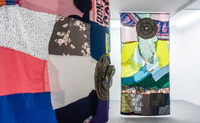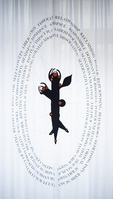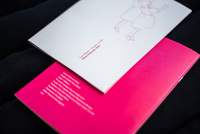At the intersection of privilege and exclusion, Pamela Bożek and Liliana Zeic fight for public status for their sisters and brothers, locals and newcomers. They confront collective acts and collective creation with empty rituals and stimulate the telling of other stories for a new world.
Inflow – an abundant accumulation of liquid or volatile substances, numerous arrivals, gathering, but also the formation of intense sensations or feelings in someone. On an individual scale, the inflow of strength accompanies the processes of regeneration, brings energy and confidence. Broadly speaking, it can mean external support, resulting in levelling or increasing opportunities. In the context of the works presented at the exhibition, it is also the apotheosis of minorities and diversity.
In her artistic practice, Pamela Bożek combines participatory actions, activism and ecological reflection. She consistently explores migration issues in response to successive humanitarian crises. In doing so, she resigns from individual authorship in favour of collective platforms, artistic collaborations and collaborations with NGOs, involving people with refugee experience in those joint processes while relying on caring practices and the equality-based exchange. At the same time, she makes us realise that the presence of the newcomers is not temporary, so it is important to plan and act for the long term.
Liliana Zeic calls for insubordination to the heteronormative paradigm, for coming out of hiding, for queer to spill over from private spheres into public space. That rainbow perspective is further accompanied by plant leadership, in which field she looks for non-human resistance strategies and the opportunities to establish new forms of community. The uniqueness of the plant kingdom lies in its pursuit of full development, free from self-centeredness, with survival and self-healing capacities that are distinct from other species. She uses this natural wisdom in her post-artistic initiatives to support recovery from trauma and empower those experiencing minority stress.
The curator’s decision to put together two artistic attitudes emphasises the potential to develop, support and grow as a community. What the two artists have in common is their activist commitment, the implementation of feminist postulates, as well as references to the theory of intersectionality, i.e. the analysis of overlapping lines of division, that go along not only genders, but also races, classes, sexual orientations, nationalities, religions, etc. In this view, a universal experience of femininity or masculinity does not exist because the privilege of some is coupled with the marginalisation of others. Due to different mechanisms of oppression, different groups also produce different tactics of resistance. One proposed strategy is to affirm and valorise differences within social movements in order to preserve unity in diversity.
At the intersection of privilege and exclusion, Pamela Bożek and Liliana Zeic fight for public status for their sisters and brothers, locals and newcomers. They confront collective acts and collective creation with empty rituals and stimulate the telling of other stories for a new world.
Pamela Bożek (1991) – visual artist and human rights activist, feminist. Graduate and doctoral student of the Academy of Fine Arts in Kraków. As part of her art practice, she is involved in post-art activities, care and charity. She cooperates with non-governmental organisations working on behalf of migrants and migrant women in Poland, including the „Dla Ziemi” Association, Ocalenie Foundation, EMIC Foundation, Kobiety Wędrowne Foundation, Dla Wolności Foundation, Homo Faber Association, Nieograniczona Foundation, Humanosh Foundation.
Liliana Zeic (1988) – visual artist, doctor of fine arts, queer feminist. Graduate of the Faculty of Fine Arts at the Nicolaus Copernicus University in Toruń, in 2011 a student at the University of Warsaw. In 2017, she defended her doctoral thesis at the WSP/Faculty of Fine Arts in Toruń (supervisor - Elżbieta Jabłońska). In her artistic practice, she analyses social issues from the perspective of radical sensitivity, including queerness and non-heteronormativity and draws on her experiences of growing up in the region of Central and Eastern Europe. She works with video, photography, objects and texts to create intermedia and performative projects based on artistic research.
__________
Womanhouse is a new series in the Kronika CCA, presenting the current situation of women in Poland through their personal stories, microherstories.
The exhibition project is a visual essay by today’s generation of female multimedia artists, based on the experience of their predecessors: those who began the process of equalising women's rights at the beginning of the 20th century, while also having a significant impact on regaining independence, and the activists of the 1960s and 1970s. The female artists invited to the project focus on the same social problems that still require a visionary approach, revising the postulates made in recent decades according to the principle: you have to look back to understand what there is still to do, and to do it well.
The title "Womanhouse" refers to two historical cultural works. The first is a psychological drama by Zofia Nałkowska. Its theatrical premiere in March 1930 was a breakthrough moment for Polish women playwrights, marking a break with the male monopoly on theatrical creation.
In Nałkowska's work, the house represents the world of women who are lonely, unhappy, living in the past, helpless without men. It is a dramatic history of women who feel unnecessary, having no influence on their own lives. At the Kronika CCA we reverse this situation, giving the symbolic Womanhouse the power to make things happen.
The second of these contexts is the landmark exhibition “Womanhouse” (1972), a landmark in the history of contemporary art, which we recall on its fiftieth anniversary. This was the first public feminist art installation and performative space, organised by Judy Chicago and Miriam Schapiro, co-founders of the California Institute of the Arts Feminist Art Program. Their intention was to transform the home environment into one that fully expressed women's experiences. In an abandoned Victorian house in Hollywood, an exhibition was held that brought feminism into the popular consciousness, which in the early 1970s was a revolutionary act and caused a lot of discussion. In the 1972 project, the artists presented 'bourgeois' women's roles and by arranging individual rooms as art installations and explored the current social consciousness.
The exhibitions at the Kronika CCA will loosely refer to this exhibition. The gallery space, originally a flat in a tenement house of the Jewish Cohn family, will be arranged by the artists and participants of the project using site-specific forms.
The visual artists we have invited expand their artistic practice to include a wide range of interdisciplinary activities. Their work is the result of analysis of social structures, consultations and workshop activities. Although the authors have different backgrounds and experiences, they conduct their artistic practice based on the pursuit of social change. They address the inequality of women in many areas: economic, educational, national minorities, ethnicity, sexuality. Some of the works will be created during workshops with Bytom women's groups.
- Exhibition
- 18 June ‒ 5 August 2022
- artist: Pamela Bożek, Liliana Zeic
- curator: Paweł Wątroba
- exhibition opening: 18.06. (Saturday), 7:00 PM–9:00 PM
- Part of the Dom Kobiet/Womanhouse cycle
- identification: Marcin Wysocki
- photo documentation: Julia Pałkowska














